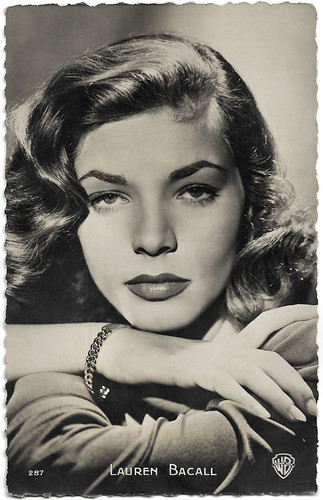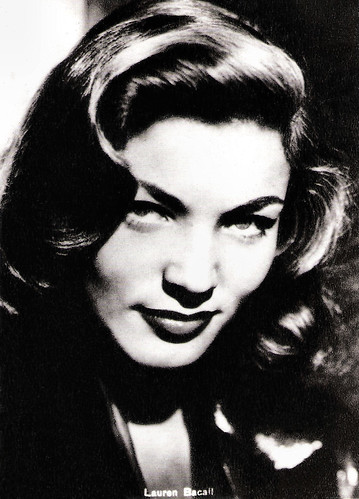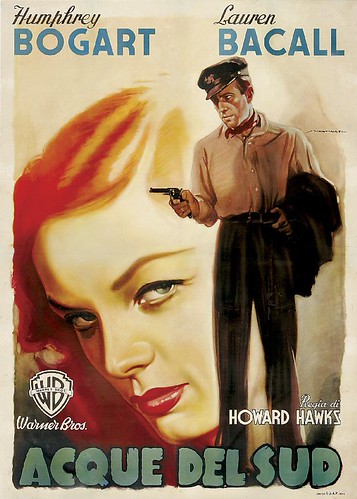
British postcard in the Picturegoer Series, London, no. W. 198. Photo: Warner Bros.

French postcard by Editions P.I., no. 287. Photo: Warner Bros.

French postcard by Editions P.I., Paris, no. 405. Photo: Warner Bros, 1953.

French postcard by Editions P.I., Paris, no. 340.

West-German postcard. Photo: 20th Century Fox.
Spotted by 'Slim' Hawks
Lauren Bacall was born Betty Joan Perske in 1924 in The Bronx in New York City. She was the daughter of Natalie Weinstein-Bacal, a Romanian Jewish immigrant, and William Perske, who was born in New Jersey, to Polish Jewish parents.
Her family was middle-class, with her father working as a salesman and her mother as a secretary. They divorced when she was five and she rarely saw her father after that.
Following a study at the American Academy of Dramatic Arts, she was crowned Miss Greenwich Village in 1942. Bacall gained nationwide attention by posing for a 1943 cover of Harper's Bazaar magazine.
This photo was spotted by Nancy Gross "Slim" Hawks, the wife of film director Howard Hawks, and prompted Hawks to put her under personal contract. He wanted to "create" a star from fresh, raw material and changed her name to Lauren Bacall. For her screen debut, Hawks cast Bacall as Marie Browning opposite Humphrey Bogart in the thriller To Have and Have Not (Howard Hawks, 1944).
Hal Erickson at AllMovie: "The young actress was so nervous that she walked around with her chin pressed against her collarbone to keep from shaking. As a result, she had to glance upward every time she spoke, an affectation which came across as sexy and alluring, earning Bacall the nickname 'The Look'. She also spoke in a deep, throaty manner, effectively obscuring the fact that she was only 19-years-old. Thanks to the diligence of Hawks and his crew - and the actress' unique delivery of such lines as "If you want anything, just whistle..." - Bacall found herself lauded as the most sensational newcomer of 1944. She also found herself in love with Humphrey Bogart, whom she subsequently married."
Bogie and Bacall co-starred in three more crime films, The Big Sleep (Howard Hawks, 1946), Dark Passage (Delmer Daves, 1947), and Key Largo (John Huston, 1948), also with Edward G. Robinson, and Lionel Barrymore. These films increased the actress' popularity, but also led critics to suggest that she was incapable of carrying a picture on her own. Bacall's disappointing solo turn opposite Charles Boyer in Confidential Agent (Herman Shumlin, 1945) seemed to confirm this.

Spanish postcard by JDP, Valencia, no. 2262.

British Real Photograph postcard, no. 251.

British postcard in the Picturegoer Series, London, no. W 198. Photo: Warner.

Belgian collectors card by Fotoprim, Brussels, for De Beukelaer, Antwerp, no. A 40. Photo: Warner Bros.
A whistle in his coffin
Lauren Bacall was a quick study and good listener, and in 1950, she starred without her husband in Bright Leaf (Michael Curtiz, 1950), a drama set in 1894 with Gary Cooper.
Before long she was turning in more first-rate performances in such films as Young Man With a Horn (Michael Curtiz, 1950) opposite Kirk Douglas and Doris Day, and the comedy How to Marry a Millionaire (Jean Negulesco, 1953) with Betty Grable and Marilyn Monroe. Her first comedy was a smash hit.
Bogart's death in 1957 after a long and painful bout with throat cancer left Lauren Bacall personally devastated. At the funeral, she put a whistle in his coffin. It was a reference to the famous line she says to him in their first film together To Have and Have Not (1944): "You know how to whistle, don't you? You just put your lips together and blow."
In the tradition of her show-must-go-on husband, she continued to perform to the best of her ability in films such as the sophisticated comedy Designing Woman (Vincente Minnelli, 1957) with Gregory Peck, and the drama The Gift of Love (Jean Negulesco, 1958) opposite Robert Stack. The latter turned out to be a big disappointment.
Denny Jackson at IMDb: "Undaunted, Lauren moved back to New York City and appeared in several Broadway plays to huge critical acclaim. She was enjoying acting before live audiences and the audiences, in turn, enjoyed her fine performances."

Belgian postcard. Photo: Warner Bros. Lauren Bacall and Charles Boyer in Confidential Agent (Herman Shumlin, 1945).

Dutch postcard. Photo: Warner Bros. Publicity still for The Big Sleep (Howard Hawks, 1946).

Belgian postcard, no. 381. Photo: Warner Bros.

Dutch postcard by J. Sleeding N.V., Amsterdam. Photo: Warner Bros.

Dutch postcard.
A legendary, outspoken Broadway actress
Lauren Bacall was away from the big screen for five years, but she returned in 1964 to appear in the thriller Shock Treatment (Denis Sanders, 1964) with Stuart Whitman and Carol Lynley, and the comedy Sex and the Single Girl (Richard Quine, 1964) with Tony Curtis, Natalie Wood, and Henry Fonda.
In 1966, Lauren starred in the crime film Harper (Jack Smight, 1966) with Paul Newman and Julie Harris. In the late 1960s, after Bacall's second marriage to another hard-case actor, Jason Robards Jr., she received only a handful of negligible film roles and all but dropped out of filmmaking.
In 1970, Bacall made a triumphant comeback in the stage production 'Applause', a musical adaptation of All About Eve (Joseph L. Mankiewicz, 1950). For her role as grand dame Margo Channing, originally played by Bette Davis in the film version, Bacall won a Tony Award.
Hal Erickson at AllMovie: "Her sultry-vixen persona long in the past, Bacall spent the '70s playing variations on her worldly, resourceful Applause role, sometimes merely being decorative (Murder on the Orient Express, 1974), but most often delivering class-A performances (The Shootist, 1976). After playing the quasi-autobiographical part of a legendary, outspoken Broadway actress in 1981's The Fan, she spent the next ten years portraying Lauren Bacall -- and no one did it better."

Italian postcard by B.F.F. Edit (Casa Editr. Ballerini & Fratini, Firenze), no. 2154. Photo: Scotty Welbourne, 1946 / Warner Bros.

Italian postcard by Bromofoto, Milano, no. 50. Photo: Warner Bros.

Italian postcard by Bromofoto, Milano, no. 169.

Italian postcard by Rotalfoto, Milano, no. 605.

Italian postcard by Turismofoto, no. 31.
Not merely a "professional personality"
Lauren Bacall was away from films again, this time for seven years. In the interim, she again appeared on the stages of Broadway. In 1981, she won her second Tony for 'Woman of the Year', based on the film Woman of the Year (George Stevens, 1942) with Katharine Hepburn.
When she returned, it was for the filming of the Agatha Christie mystery Appointment with Death (Michael Winner, 1988) with Peter Ustinov as Hercule Poirot, and Mr. North (Danny Huston, 1988), starring Anthony Edwards and Robert Mitchum.
Then followed the Stephen King adaptation Misery (Rob Reiner, 1990) and several made-for-television films. In one of these, The Portrait (Arthur Penn, 1993, she and her Designing Woman co-star Gregory Peck played a still-amorous elderly couple. Once more, Bacall proved here that she was a superb actress and not merely a "professional personality".
In 1994, she paid tribute to her first role as 'Slim' in To Have and Have Not with a character called 'Slim Chrysler' in Prêt-à-Porter (Robert Altman, 1994), released to theatres fifty years after the premiere of To Have and Have Not (Howard Hawks, 1944).
During the filming of The Mirror Has Two Faces (Barbra Streisand, 1996), Lauren Bacall traveled to France to accept a special César Award for her lifetime achievement in film. For her role in Mirror, which cast her as Barbra Streisand's mother, Bacall earned a Golden Globe award and an Oscar nomination.
She continued to work on a number of projects into the next decade, including Diamonds (John Asher, 1999), in which she appeared alongside Kirk Douglas, with whom she had last co-starred in the romantic drama Young Man with a Horn (Michael Curtiz, 1950).
In the new century, she worked twice with internationally respected filmmaker Lars von Trier, appearing in his films Dogville (2003) with Nicole Kidman, and Manderlay (2005) with Willem Dafoe. She was in the Nicole Kidman film Birth (Jonathan Glazer, 2004) and appeared in the documentary Cameraman: The Life and Work of Jack Cardiff (Craig McCall, 2010). Bacall won an Honorary Oscar in 2010.
Her autobiography, 'By Myself and Then Some', won a National Book Award in 1980. Lauren Bacall died in 2014 in New York, at age 89. She was the mother of producer Stephen H. Bogart (1949), Leslie Bogart (1952), and actor Sam Robards (1961).

French postcard by Imp. De Marchi Frères, Marseille. With Humphrey Bogart.

Yugoslavian postcard by ZK, no. 3910.

Vintage postcard, no. C 120.

American postcard by Rizzoli International Bookstore, New York, 1984. Photo: Ruth Orkin. Caption: Lauren Bacall at the St. Regis, NYC, 1950.

Italian Film poster 'Acque del sud' (To Have and Have Not, 1944), designed by Luigi Martinati. This poster was published on our old blog Truus, Bob and Jan too! say: Hello World (truus-bob.livejournal.com/) with a comment on Luigi Martinati.
Sources: Hal Erickson (AllMovie), Denny Jackson (IMDb), Wikipedia, and IMDb.
No comments:
Post a Comment